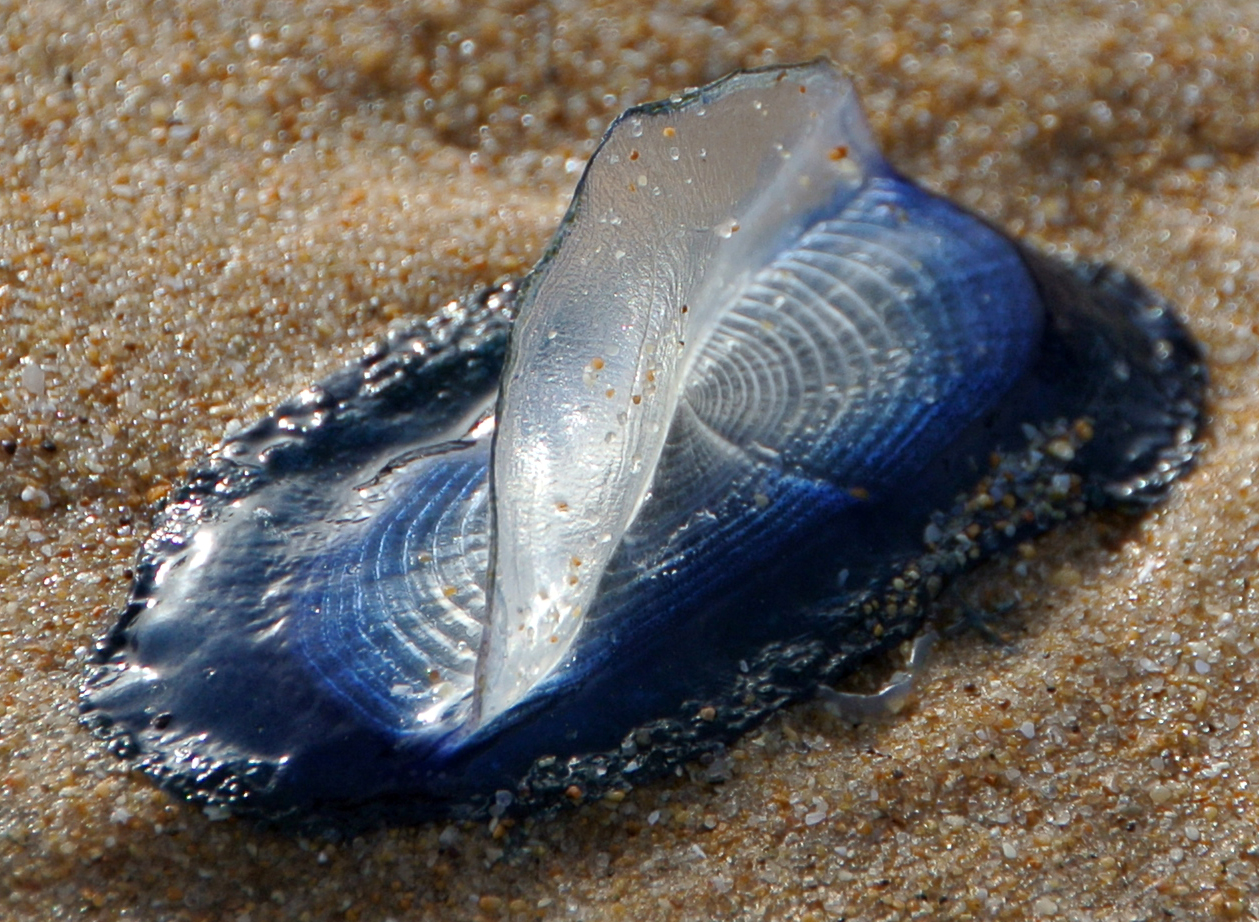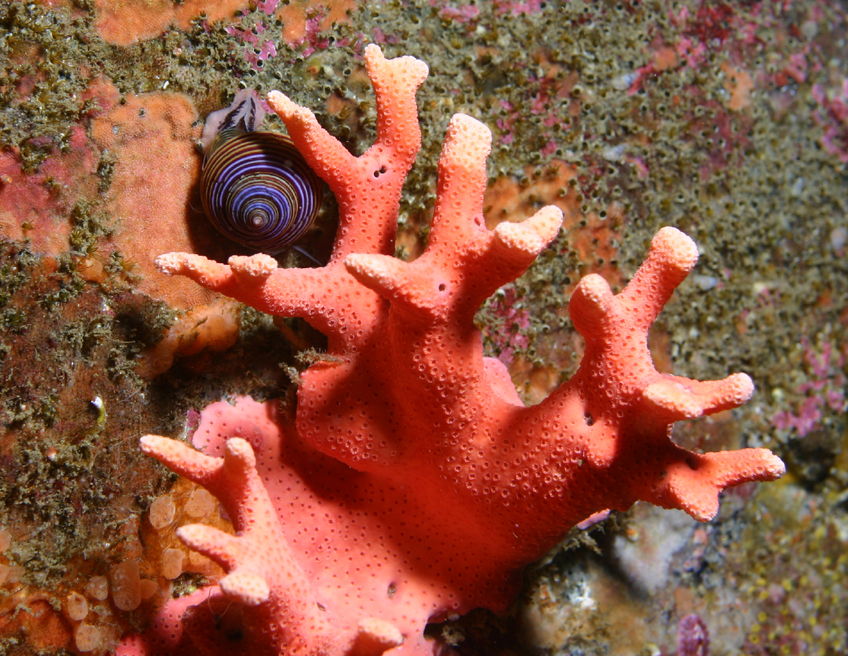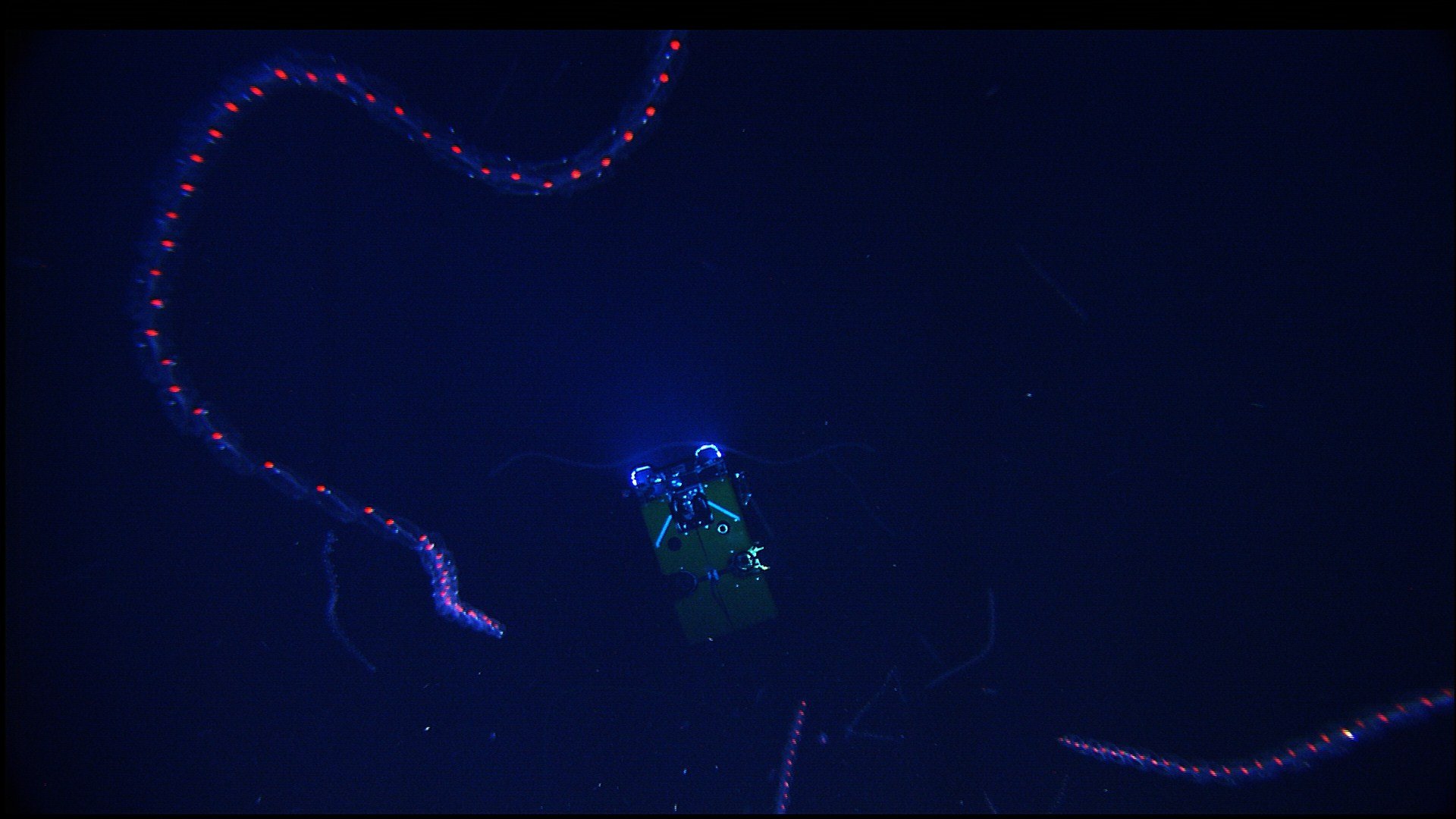|
Porpitidae
The chondrophores or porpitids are a small group of hydrozoans in the family Porpitidae. Though it derives from an outdated name for this lineage (see below), some still find the term "chondrophore" useful as a synonym to "porpitid" in discussions of the two genera contained therein. They all live at the surface of the open ocean, and are colonies of carnivorous, free-floating hydroids whose role in the plankton community is similar to that of pelagic jellyfish. The chondrophores look like a single organism but are actually colonial animals, made up of orderly cooperatives of polyps living under specialized sail-structures. The most familiar members of the family Porpitidae are the blue button (''Porpita porpita'') and the by-the-wind sailor (''Velella velella''). Description The tiny individual animals are specialized to perform specific tasks; some form the central gas-filled disc (which is a golden brown colour and hardened by chitinous material) essential to keeping the ... [...More Info...] [...Related Items...] OR: [Wikipedia] [Google] [Baidu] |
Velella
''Velella'' is a monospecific genus of hydrozoa in the Porpitidae family. Its only known species is ''Velella velella'', a cosmopolitan free-floating hydrozoan that lives on the surface of the open ocean. It is commonly known by the names sea raft, by-the-wind sailor, purple sail, little sail, or simply ''Velella''. This small cnidarian is part of a specialised ocean surface community that includes the better-known cnidarian siphonophore, the Portuguese man o' war. Specialized predatory gastropod molluscs prey on these cnidarians. Such predators include nudibranchs (sea slugs) in the genus ''Glaucus''Gosliner, T.M. (1987). ''Nudibranchs of Southern Africa'' page 127, and purple snails in the genus ''Janthina''.Branch, G.M., Branch, M.L, Griffiths, C.L. and Beckley, L.E. (2010). ''Two Oceans: a guide to the marine life of southern Africa.'' Cape Town:Struik Nature. page 188. . Each apparent individual is a hydroid colony, and most are less than about 7 cm long. They are us ... [...More Info...] [...Related Items...] OR: [Wikipedia] [Google] [Baidu] |
Velella Sicily 060613
''Velella'' is a monospecific genus of hydrozoa in the Porpitidae family. Its only known species is ''Velella velella'', a cosmopolitan free-floating hydrozoan that lives on the surface of the open ocean. It is commonly known by the names sea raft, by-the-wind sailor, purple sail, little sail, or simply ''Velella''. This small cnidarian is part of a specialised ocean surface community that includes the better-known cnidarian siphonophore, the Portuguese man o' war. Specialized predatory gastropod molluscs prey on these cnidarians. Such predators include nudibranchs (sea slugs) in the genus ''Glaucus''Gosliner, T.M. (1987). ''Nudibranchs of Southern Africa'' page 127, and purple snails in the genus ''Janthina''.Branch, G.M., Branch, M.L, Griffiths, C.L. and Beckley, L.E. (2010). ''Two Oceans: a guide to the marine life of southern Africa.'' Cape Town:Struik Nature. page 188. . Each apparent individual is a hydroid colony, and most are less than about 7 cm long. They are ... [...More Info...] [...Related Items...] OR: [Wikipedia] [Google] [Baidu] |
By-the-wind Sailor
''Velella'' is a monospecific genus of hydrozoa in the Porpitidae family. Its only known species is ''Velella velella'', a cosmopolitan free-floating hydrozoan that lives on the surface of the open ocean. It is commonly known by the names sea raft, by-the-wind sailor, purple sail, little sail, or simply ''Velella''. This small cnidarian is part of a specialised ocean surface community that includes the better-known cnidarian siphonophore, the Portuguese man o' war. Specialized predatory gastropod molluscs prey on these cnidarians. Such predators include nudibranchs (sea slugs) in the genus ''Glaucus''Gosliner, T.M. (1987). ''Nudibranchs of Southern Africa'' page 127, and purple snails in the genus ''Janthina''.Branch, G.M., Branch, M.L, Griffiths, C.L. and Beckley, L.E. (2010). ''Two Oceans: a guide to the marine life of southern Africa.'' Cape Town:Struik Nature. page 188. . Each apparent individual is a hydroid colony, and most are less than about 7 cm long. They are ... [...More Info...] [...Related Items...] OR: [Wikipedia] [Google] [Baidu] |
Anthomedusae
Anthoathecata, or the athecate hydroids, are an order of hydrozoans belonging to the phylum Cnidaria. A profusion of alternate scientific names exists for this long-known, heavily discussed, and spectacular group. It has also been called Gymnoblastea and (with or without an emended ending ''-ae''), Anthomedusa, Athecata, Hydromedusa, and Stylasterina. There are about 1,200 species worldwide.Schuchert, P. (2014). Anthoathecata. Accessed through: Schuchert, P. (2014) World Hydrozoa database at http://www.marinespecies.org/hydrozoa/aphia.php?p=taxdetails&id=13551 on 2014-10-31 These hydrozoans always have a polyp stage. Their hydranths grow either solitary or in colonies. There is no firm perisarc around the polyp body. The medusae, or jellyfish, are solitary animals, with tentacles arising from the bell margin, lacking statocysts but possessing radial canals. Their gonads are on the manubrium ("handle").Bouillon, J.; Gravili, C.; Pagès, F.; Gili, J.-M.; Boero, F. (2006). An intro ... [...More Info...] [...Related Items...] OR: [Wikipedia] [Google] [Baidu] |
Hydrozoan
Hydrozoa (hydrozoans; ) are a taxonomic class of individually very small, predatory animals, some solitary and some colonial, most of which inhabit saline water. The colonies of the colonial species can be large, and in some cases the specialized individual animals cannot survive outside the colony. A few genera within this class live in freshwater habitats. Hydrozoans are related to jellyfish and corals and belong to the phylum Cnidaria. Some examples of hydrozoans are the freshwater jelly (''Craspedacusta sowerbyi''), freshwater polyps ('' Hydra''), ''Obelia'', Portuguese man o' war (''Physalia physalis''), chondrophores (Porpitidae), "air fern" (''Sertularia argentea''), and pink-hearted hydroids (''Tubularia''). Anatomy Most hydrozoan species include both a polypoid and a medusoid stage in their lifecycles, although a number of them have only one or the other. For example, ''Hydra'' has no medusoid stage, while '' Liriope'' lacks the polypoid stage. Polyps The hydroid fo ... [...More Info...] [...Related Items...] OR: [Wikipedia] [Google] [Baidu] |
Hydrozoa
Hydrozoa (hydrozoans; ) are a taxonomic class of individually very small, predatory animals, some solitary and some colonial, most of which inhabit saline water. The colonies of the colonial species can be large, and in some cases the specialized individual animals cannot survive outside the colony. A few genera within this class live in freshwater habitats. Hydrozoans are related to jellyfish and corals and belong to the phylum Cnidaria. Some examples of hydrozoans are the freshwater jelly (''Craspedacusta sowerbyi''), freshwater polyps ('' Hydra''), ''Obelia'', Portuguese man o' war (''Physalia physalis''), chondrophores (Porpitidae), "air fern" (''Sertularia argentea''), and pink-hearted hydroids (''Tubularia''). Anatomy Most hydrozoan species include both a polyp (zoology), polypoid and a medusa (biology), medusoid stage in their lifecycles, although a number of them have only one or the other. For example, ''Hydra'' has no medusoid stage, while ''Liriope tetraphylla, Lir ... [...More Info...] [...Related Items...] OR: [Wikipedia] [Google] [Baidu] |
Porpita
''Porpita'' is genus of hydrozoans in the family Porpitidae. It has two species recognized and is the type genus of its family Family (from la, familia) is a Social group, group of people related either by consanguinity (by recognized birth) or Affinity (law), affinity (by marriage or other relationship). The purpose of the family is to maintain the well-being of its .... Porpita is also in the phylum Cnidarian. Similar to the well-known Portuguese Man-of-War, species in this genus consist mainly of colonies of hydrozoans, linked to a biological float, keeping them near the surface. Unlike the Man-of-War, however, the porpita lacks a sail and therefore does not get blown ashore as often. Organisms from this genus reside in tropical to sub-tropical waters all around the world. Like other cnidarians, organisms from this genus possess stinging cells called cnidoblasts. The most common species of this genus is the ''Porpita porpita'', more commonly known as the "Blue Button ... [...More Info...] [...Related Items...] OR: [Wikipedia] [Google] [Baidu] |
Porpita Porpita
''Porpita porpita'', or blue button, is a marine organism consisting of a colony of hydroids found in the warmer, tropical and sub-tropical waters of the Pacific, Atlantic, and Indian oceans, as well as the Mediterranean Sea and eastern Arabian Sea.Gul, Shahnawaz & Gravili, Cinzia. (2014). On the occurrence of Porpita porpita (Cnidaria: Hydrozoa) at Pakistan coast (North Arabian Sea). Marine Biodiversity Records. 7. 10.1017/S1755267214000189. It was first identified by Carl Linnaeus in 1758, under the basionym ''Medusa porpita''.Lillo, Antonio & Tiralongo, Francesco & Tondo, Elena. (2019). New Records of Porpita porpita (Linnaeus, 1758) (Cnidaria: Hydrozoa) in the Mediterranean Sea. Natural and Engineering Sciences. 4. 293-298. 10.28978/nesciences.646425.Calder, Dale. (2010). Some anthoathecate hydroids and limnopolyps (Cnidaria, Hydrozoa) from the Hawaiian archipelago. Zootaxa. 2590. 10.11646/zootaxa.2590.1.1. In addition, it is one of the two genera under the suborder Chondropho ... [...More Info...] [...Related Items...] OR: [Wikipedia] [Google] [Baidu] |
Capitata
Capitata is a suborder of Hydrozoa, a class of marine invertebrates belonging to the phylum Cnidaria. Characteristics Members of this suborder are characterised by the tentacles of the polyps terminating in knobs. In some species these are only present in juvenile forms being replaced in adults by more threadlike tentacles. A high nematocyst concentration is present in the knobs. A few species in this group are better known as their solitary medusa form than as their polyp form. These include ''Sarsia'', '' Polyorchis'' and '' Cladonema''. Families According to the World Register of Marine Species, the following families are found in this suborder : * Asyncorynidae Kramp, 1949 * Cladocorynidae Allman, 1872 * Cladonematidae Gegenbaur, 1857 * Corynidae Johnston, 1836 * Halimedusidae Arai & Brinckmann-Voss, 1980 * Hydrocorynidae Rees, 1957 *Milleporidae Fleming, 1828 * Moerisiidae Poche, 1914 * Pennariidae McCrady, 1859 *Porpitidae Goldfuss, 1818 * Pseudosolanderiidae Bouillo ... [...More Info...] [...Related Items...] OR: [Wikipedia] [Google] [Baidu] |
Siphonophorae
Siphonophorae (from Greek ''siphōn'' 'tube' + ''pherein'' 'to bear') is an order within Hydrozoa, which is a class of marine organisms within the phylum Cnidaria. According to the World Register of Marine Species, the order contains 175 species thus far. Although a siphonophore may appear to be an individual organism, each specimen is in fact a colonial organism composed of medusoid and polypoid zooids that are morphologically and functionally specialized. Zooids are multicellular units that develop from a single fertilized egg and combine to create functional colonies able to reproduce, digest, float, maintain body positioning, and use jet propulsion to move. Most colonies are long, thin, transparent floaters living in the pelagic zone. Like other hydrozoans, some siphonophores emit light to attract and attack prey. While many sea animals produce blue and green bioluminescence, a siphonophore in the genus ''Erenna'' was only the second life form found to produce a red li ... [...More Info...] [...Related Items...] OR: [Wikipedia] [Google] [Baidu] |
Ocean
The ocean (also the sea or the world ocean) is the body of salt water that covers approximately 70.8% of the surface of Earth and contains 97% of Earth's water. An ocean can also refer to any of the large bodies of water into which the world ocean is conventionally divided."Ocean." ''Merriam-Webster.com Dictionary'', Merriam-Webster, [...More Info...] [...Related Items...] OR: [Wikipedia] [Google] [Baidu] |
Order (biology)
Order ( la, wikt:ordo#Latin, ordo) is one of the eight major hierarchical taxonomic ranks in Linnaean taxonomy. It is classified between Family_(biology), family and Class_(biology), class. In biological classification, the order is a taxonomic rank used in the classification of organisms and recognized by the nomenclature codes. An immediately higher rank, superorder, is sometimes added directly above order, with suborder directly beneath order. An order can also be defined as a group of related families. What does and does not belong to each order is determined by a taxonomist, as is whether a particular order should be recognized at all. Often there is no exact agreement, with different taxonomists each taking a different position. There are no hard rules that a taxonomist needs to follow in describing or recognizing an order. Some taxa are accepted almost universally, while others are recognized only rarely. The name of an order is usually written with a capital letter. Fo ... [...More Info...] [...Related Items...] OR: [Wikipedia] [Google] [Baidu] |






.jpg)

